Why this story, and why now? Well, this week, we were testing the 2023 Ford F-150 Lighting battery-electric pickup truck. Due to bad planning and bad weather hitting at once, I needed to go buy a birthday cake during a wicked Nor’easter ice and snow storm. Off I went in the terrible road conditions in a (gasp!) electric vehicle! I made a quick stop for coffee. Puling in, I realized, there were only electric vehicles in the parking lot. Three of them. I went for my camera, and a fourth drove in. There was a Tesla Model Something, a 2023 Ford F-150 Lightning, a Chevy Volt, and then a Fusion Energi joined the crowd. How many Subarus with studded snow tires had ventured out? Zip. How many Wranglers with tire chains? Nada. Just EVs riding along on hard-as-stone all-season EV tires.
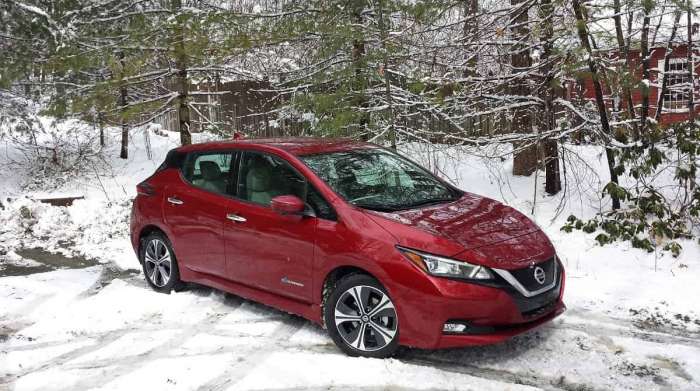
Related Story From 2018 - Can Electric Vehicles Like the Nissan Leaf Handle Winter?
Let’s Keep It Real - There Are Better Winter Vehicles Than BEVs.
Battery-electric vehicles (BEVs) are not the best type of vehicle for winter driving. What is? Maybe a Subaru Forester Wilderness, which comes standard from the factory with all-wheel drive, three snow modes, nine inches of ground clearance, and tires rated for severe snow duty. Not a single battery-electric vehicle can boast that combination. In today’s U.S. vehicle portfolio, there are winter-specific trims from Toyota, Ram, Mazda, Subaru, and a few other brands. There are no winter-focused EVs. That said, do you think BEV advocates are going just to walk away from an imperfect situation? No.
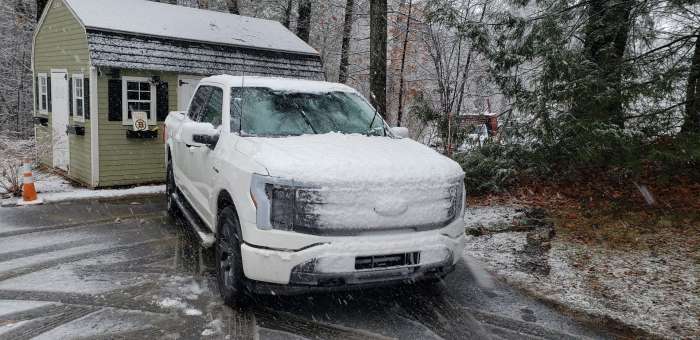
Why Battery-Electric Vehicles Are “Weaker” In Winter
There are four primary reasons why battery-electric vehicles are weaker than some plug-in hybrid, hybrid, and gas-only vehicle models and trims when winter weather hits. Here is the main list:
1) Nearly all BEVs ship with tires optimized for low rolling resistance. This design parameter is at odds with optimal winter compounds and winter tread designs.
2) BEVs lose considerable range in winter for a few reasons. Top among those reasons is battery chemistry and HVAC draw.
3) BEVs take longer than usual to charge in cold temperatures.
4) BEVs generally (not always) lack a spare tire. Anyone with a flat in winter learns that a can of gunk in the trunk is just an insult.

Oh My, Mercy Me, How Will EV Drivers Ever Survive In Winter?!
So how will battery-electric vehicle fans who wish to operate in wintery conditions adapt to and overcome deficiencies in current-day BEV designs? Well, it’s not rocket science, but we can spell it out.
- BEV owners who want to be able to stop and turn in winter snow and ice will change the tires that the car uses to winter-specific designs or to 4-season winter-rated tires like the Michelin CrossClimate2 or the Falken WilkPeak A/T Trail. Whichever fits their needs best. The primary downside to this change will be a slight reduction in efficiency and range. Slight means a handful of miles over the vehicle’s maximum range.
- BEV owners will charge more often in winter. They will also adopt new habits, such as keeping the vehicle on the charger even when they have enough range so that they don't need to warm the cabin when unplugged. This is called cabin preconditioning.
- BEV owners will schedule their day so that they have added charging time if away from their home charger.
- It is possible to buy a BEV with a spare. By our count, there are now 13 EV models on sale in America, including some BEVs with full-size matching spares and many plug-in hybrid-electric vehicles with spares. EV owners who plan to be operating in harsh winter conditions may opt to buy one of the BEV models, such as the Jaguar I-Pace, F-150 Lightning, Hummer SUV or Truck, Rivian SUV or truck, or opt for one of the many PHEVs with a spare. Or they will simply buy a spare tire from a source like Modern Spare and secure it in the cargo area.
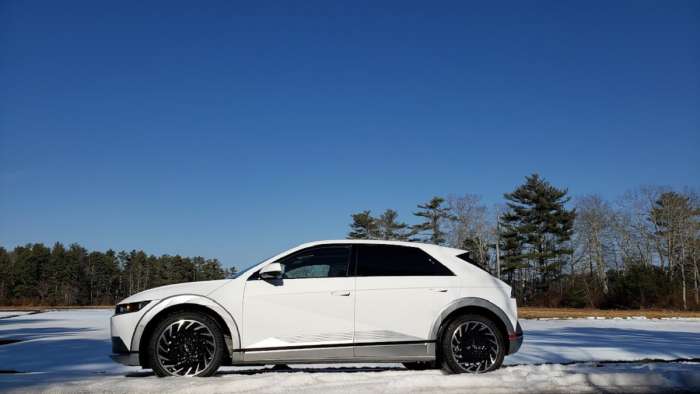
Here’s One Way EVs Are Better In Winter
In cold weather, many of the BEVs we have recently tested, such as the Hyundai Kona EV, have demonstrated excellent heating systems. Quicker to warm the cabin than many conventionally-powered vehicles, which can take five minutes or more of driving to warm up enough to offer heat. BEVs also seem more likely to offer heated seats and a heated steering wheel than conventional models. This is just sensible engineering. Put the heat where it has the most impact.
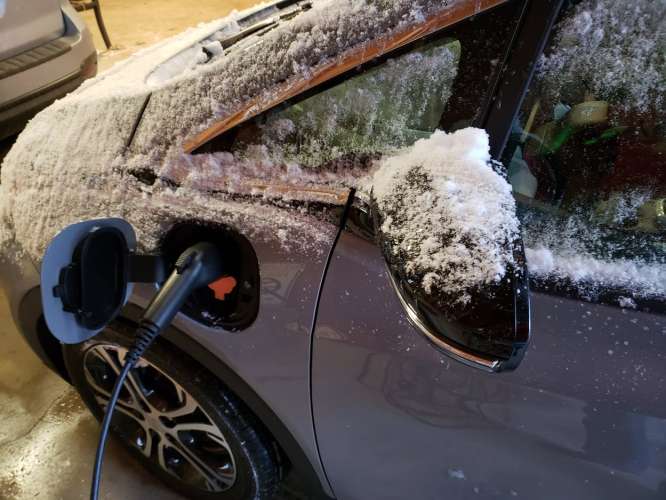
Range Is Already A Problem - So What’re A Few Less Miles Between Friends?
In our normal testing of BEVs, we have not had any winter situations where the range was more of a limit to our travel than it would have been in warm weather. Let’s face it; if you are looking for a long-range vehicle with more than four uninterrupted hours of driving without a stop, battery electrics are not your thing. What is? Maybe a Prius Prime with its 600-plus operating range? But how many Americans actually need a vehicle that can drive for ten hours without a stop? Nearly none. And how many EV owners don't have the opportunity to charge “to full” each evening if they wish at home? A small minority.
Related Story: 3 Best Ways To Extend EV Range In Winter
No Vehicle Is Perfect For All Occasions
Battery-electric vehicles are not all things to all people. Nor is a Jeep Wrangler Rubicon 392. Or a Mazda Miata. Or a Ford Maverick Hybrid XL. All of which may well sit in a BEV owner’s garage next to their Leaf, Bolt, Lightning, Kona EV, or Ioniq 5.
UnClick the Bait
The next time you see a clickbait YouTube video claiming, “EVs don't work in winter!!” maybe just skip past that story and read a more honest one - if you can resist! You are in control of what content you opt to consume and what urban myths you opt to embrace.
Ps - You may think we are just jumping on the bandwagon to defend the Lightning here, but we have been testing EVs in snow for the better part of a decade and telling it like it is.
John Goreham is an experienced New England Motor Press Association member and expert vehicle tester. John completed an engineering program with a focus on electric vehicles, followed by two decades of work in high-tech, biopharma, and the automotive supply chain before becoming a news contributor. In addition to his ten years of work at Torque News, John has published thousands of articles and reviews at American news outlets. He is known for offering unfiltered opinions on vehicle topics. You can follow John on Twitter, and TikTok @ToknCars, and view his credentials at Linkedin
EVs in snow images by John Goreham








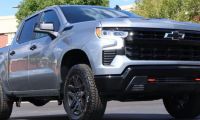
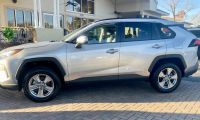
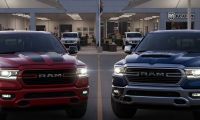
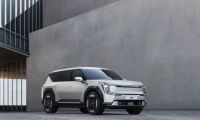
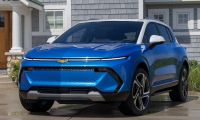
Comments
Range anxiety and cold
Permalink
Range anxiety and cold weather effects are typical concerns of people looking at EVs. Thanks for the pictures and story illustrating that those adverse conditions don't prevent EVs from being useful winter vehicles.
We have been driving a Plug
Permalink
In reply to Range anxiety and cold by DeanMcManis (not verified)
We have been driving a Plug In hybrid for 5 years now (Honda Clarity). We love the car, it’s ashamed that Honda discontinued it due to poor sales. Yet whenever I saw a commercial from Honda during its years in production, the Clarity was never mentioned. Most people I run into have never heard of it. We live Northernmost NY near the Canadian border. Winters can be harsh up here, so we keep it in a heated garage with a level 2 charger. Even with all that we still lose sometimes over half of our range in the winter. We are glad it has a normal combustion engine to keep us going. I feel a total electric vehicle up here is currently unpractical in rural areas, which is where we live. I also feel that this country is putting the cart before the horse so to say. If everyone in the country were to convert to EV’s today or a two years from today, the power grid would not be able to handle it. Even with the vast majority of folks still driving combustion engine vehicles the large cities still have rolling brownouts. Adding a bunch of EV’s to the grid even if only plugged in at night would most likely crash the grid. This country needs to severely upgrade the power grid before pushing EV’s. The cost to get it right will be enormous, so the course we are on is headed for disaster.
Upgrading the power grid
Permalink
In reply to We have been driving a Plug by Robert Verrier (not verified)
Upgrading the power grid before there is the demand for the power probably won’t happen in most areas. Nobody expects everybody to replace their gas fueled vehicles at once. Upgrading the electrical grid can be expected to mirror the slow pace of upgrading the broadband grid, quickly in some areas, haphazard and slow in others.
Pssst!
Permalink
Pssst!
There’s no reason to switch to EVs. You will not change the weather in 30 years. Carbon is good; makes the earth greener.The glacialion periods of the earth will continue as they have for millennia.
No EV for me!!!!!
So.. you drive a truck that
Permalink
So.. you drive a truck that gets less than half the range of mine, has no spare tire, contains a lithium battery which is a MASSIVE environmental hazard, only reduces fossil fuel usage by 4% (it takes fossil fuels to make your battery and charge your car, Einstein), fails so miserably in winter that you have to reschedule your life around charging, and it costs 3x more than my truck?
Lol. I’ll pass.
You say in the article the
Permalink
You say in the article the charging network works well for most people because they charge at home. I plug in my Leaf in my garage. EV owners living in single family homes can charge at home. The major deficiency in the charging network is not limited charging capacity in rural areas it is there are few charging stations in multi family housing, either condo or rental. The IRA legislation includes a large amount of funding to upgrade the charging network on highways and roads. There are tax credits for other charging infrastructure upgrades but whether cities, states and private multi family housing owners will quickly get on the wagon is yet to be seen.
Winter driving? None of my BEV friends here in Wisconsin and Michigan complain about winter driving problems. Most of us travel 20-100 miles per day. The people who go 100 miles a day have models with 220-350 miles so even in winter there’s no problem. My Leaf’s battery degrades from 100-115 in the summer to 80-88 miles on the coldest days. My wife and I drive 20-30 miles per day.
The folks who swear their gas/diesel current cars and trucks are far superior to any BEV available, this may be true for now. The folks who say a comparable BEV is hugely more` expensive than what they have now are right and wrong. The upfront cost today for a BEV is more than a gas/diesel vehicle. Electric vehicles lifetime cost of purchase, fuel and maintenance will be significantly less.
As to the amount of minerals needed for the batteries and how that will deplete the earth, some of the minerals are rare and others are plentiful. Future batteries will reuse recycled materials and other more environmental materials. Electric vehicle use will reduce carbon and other greenhouse gases in the atmosphere.